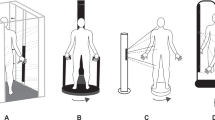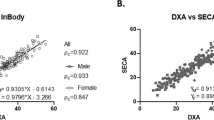Abstract
Objective:
To evaluate interdevice reliability in body density (Db) and percent body fat (%BF) using air-displacement plethysmography, the BOD POD (BP) body composition system.
Design and Setting:
Duplicate body composition tests were performed in immediate succession on 50 adults (26 M, 24F; 21–53 y) using two BP units located in the same body composition laboratory.
Results:
Mean Db and %BF between BP1 and BP2 did not differ significantly for men (ΔDb=0.0003±0.0008 g/ml, P=0.632; Δ%BF=0.1±1.3, P=0.665), while for women, there were small but significant differences in Db and %BF between BP1 and BP2 (ΔDb=0.0018±0.0003 g/ml, P=0.001; Δ%BF=0.8±1.1, P=0.001). The regression between %BF by BP1 and BP2 did not deviate significantly from the line of identity for both men and women (R2=0.95, standard error of estimate (s.e.e.)=1.23 %BF for men; R2=0.97, s.e.e=1.13 %BF for women). Individual variations in %BF estimates between the two BP units were within acceptable ranges (95% limits of agreement=−2.5–2.7 %BF for men; −1.4–3.0 %BF for women), and there was no trend in individual differences as %BF varied (r=−0.19, P=0.359 for men; r=0.09, P=0.677 for women). Other subject characteristics, including age, body mass, height, and body mass index, did not significantly contribute to the differences in %BF estimates by the two BP units.
Conclusions:
No clinically significant differences in Db and %BF estimates exist between the BP units, and the interdevice variability of the BP has minimal impact on %BF estimates. Further, test-to-test reliability between BP units appears to be as good as within one unit.
This is a preview of subscription content, access via your institution
Access options
Subscribe to this journal
Receive 12 print issues and online access
$259.00 per year
only $21.58 per issue
Buy this article
- Purchase on Springer Link
- Instant access to full article PDF
Prices may be subject to local taxes which are calculated during checkout

Similar content being viewed by others
References
Bonge D & Donnelly JE (1989): Trials to criteria for hydrostatic weighing at residual volume. Res. Q. 60, 176–179.
Buchholz AC, Majchrzak KM, Chen KY, Shankar SM & Buchowski MS (2004): Use of air displacement plethysmography in the determination of percentage of fat mass in African American children. Pediatr. Res. 56, 47–54.
Collins AL & McCarthy HD (2003): Evaluation of factors determining the precision of body composition measurements by air displacement plethysmography. Eur. J. Clin. Nutr. 57, 770–776.
Collins AL, Saunders S, McCarthy HD, Williams JE & Fuller NJ (2004): Within- and between-laboratory precision in the measurement of body volume using air displacement plethysmography and its effect on body composition assessment. Int. J. Obes. Relat. Metab. Disord. 28, 80–90.
Collins MA, Millard-Stafford ML & Sparling PB (1999): Evaluation of the BOD POD for assessing body fat in collegiate football players. Med. Sci. Sports Exerc. 31, 1350–1356.
Demerath EW, Guo SS, Chumlea WC, Towne B, Roche AF & Siervogel RM (2002): Comparison of percent body fat estimates using air displacement plethysmography and hydrodensitometry in adults and children. Int. J. Obes. Relat. Metab. Disord. 26, 389–397.
Dempster P & Aitkens S (1995): A new air displacement method for the determination of human body composition. Med. Sci. Sports Exerc. 27, 1692–1697.
Ellis KJ & Shypailo RJ (1998): Bone mineral and body composition measurements: cross-calibration of pencil-beam and fan-beam dual-energy X-ray absorptiometers. J. Bone Miner. Res. 13, 1613–1618.
Fields DA, Goran MI & McCrory MA (2002): Body-composition assessment via air-displacement plethysmography in adults and children: a review. Am. J. Clin. Nutr. 75, 453–467.
Fields DA, Wilson GD, Gladden LB, Hunter GR, Pascoe DD & Goran MI (2001): Comparison of the BOD POD with the four-compartment model in adult females. Med. Sci. Sports Exerc. 33, 1605–1610.
Girandola RN, Wiswell RA, Mohler JG, Romero GT & Barnes WS (1977): Effects of water immersion on lung volumes: implications for body composition analysis. J. Appl. Physiol. 43, 276–279.
Iwaoka H, Yokoyama T, Nakayama T, Matsumura Y, Yoshitake Y, Fuchi T, Yoshiike N & Tanaka H (1998): Determination of percent body fat by the newly developed sulfur hexafluoride dilution method and air displacement plethysmography. J. Nutr. Sci. Vitaminol. 44, 561–568.
Jensen MD, Kamaley JA & Roust LR (1993): Assessment of body composition with use of dual-energy x-ray absorptiometry: evaluation and comparison with other methods. Mayo. Clin. Proc. 68, 867–873.
Katch FI (1968): Apparent body density and variability during underwater weighing. Res. Q. 39, 993–999.
Levenhagen DK, Borel MJ & Welch DC (1999): A comparison of air displacement plethysmography with three other techniques to determine body fat in healthy adults. J. Parenter. Enteral. Nutr. 23, 293–299.
Lohman TG (1992): Advance in Body Composition Assessment. Champaign, IL: Human Kinetics Publishers.
McCrory MA, Gomez TD, Bernauer EM & Mole PA (1995): Evaluation of a new air displacement plethysmograph for measuring human body composition. Med. Sci. Sports Exerc. 27, 1686–1691.
McCrory MA, Mole PA, Gomez AL, Dewey KG & Bernauer EM (1998): Body composition by air-displacement plethysmography by using predicted and measured thoracic gas volumes. J. Appl. Physiol. 84, 1475–1479.
Miyatake N, Nonaka K & Fujii M (1999): A new air displacement plethysmograph for the determination of Japanese body composition. Diabetes Obes. Metab. 1, 347–351.
Morrow JR, Jackson AS, Bradley PW & Hartung GH (1986): Accuracy of measured and predicted residual lung volume on body density measurement. Med. Sci. Sports Exerc. 18, 647–652.
Paton NIJ, Macallan DC, Jebb SA, Pazianas M & Griffin GE (1995): Dual-energy X-ray absorptiometry results differ between machines. Lancet 346, 899–900.
Siri WE (1961): Body composition from fluid spaces and density: analysis of methods, In Techniques for Measuring Body Composition, eds J Brozek and A Henschel, pp 223–244. Washington, DC: National Academy Sciences, National Research Council.
Tataranni PA, Pettitt DJ & Ravussin E (1996): Dual energy X-ray absorptiometry: inter-machine variability. Int. J. Obes. Relat. Metab. Disord. 20, 1048–1050.
Tothill P, Avenell A, Love J & Reid DM (1994): Comparisons between Hologic, Lunar and Norland dual-energy X-ray absorptiometers and other techniques used for whole-body soft tissue measurements. Eur. J. Clin. Nutr. 48, 781–794.
Tothill P, Hannan WJ & Wilkinson S (2001): Comparison between a pencil beam and two fan beam dual energy X-ray absorptiometers used for measuring total body bone and soft tissue. Br. J. Radiol. 74, 166–176.
Tylavsky FA, Fuerst T, Nevitt M, Dockrell M, Wan JY, Cauley J & Harris T (2000): Measurement of changes in soft tissue mass and fat mass with weight change: pencil- vs fan-beam dual-energy X-ray absorptiometry. Ann. NY Acad. Sci. 904, 94–97.
Van Loan MD, Keim NL, Berg K & Mayclin PL (1995): Evaluation of body composition by dual energy x-ray absorptiometry and two different software packages. Med. Sci. Sports Exerc. 27, 587–591.
Wagner DR & Heyward VH (2000): Validation of air displacement plethysmography for assessing body composition. Med. Sci. Sports Exerc. 32, 1339–1344.
Weyers AM, Mazzetti SA, Love DM, Gomez AL, Kraemer WJ & Volek JS (2002): Comparison of methods for assessing body composition changes during weight loss. Med. Sci. Sports Exerc. 34, 497–502.
Acknowledgements
We thank Captain Patrick Oneill of Scott Air Force Base, Illinois Health and Wellness Center for help in data collection. Thanks also to Life Measurement Inc. (LMI) for their technical support and assistance in manuscript preparation. The results of this study were in no way biased by LMI or its representatives. The results of this study do not constitute endorsement of the product by the author or by EJCN.
Author information
Authors and Affiliations
Corresponding author
Rights and permissions
About this article
Cite this article
Ball, S. Interdevice variability in percent fat estimates using the BOD POD. Eur J Clin Nutr 59, 996–1001 (2005). https://doi.org/10.1038/sj.ejcn.1602202
Received:
Revised:
Accepted:
Published:
Issue Date:
DOI: https://doi.org/10.1038/sj.ejcn.1602202
Keywords
This article is cited by
-
Growth and metabolic outcome in adolescents born preterm (GROWMORE): follow-up protocol for the Newcastle preterm birth growth study (PTBGS)
BMC Pediatrics (2013)
-
Changes in thoracic gas volume with air-displacement plethysmography after a weight loss program in overweight and obese women
European Journal of Clinical Nutrition (2008)



